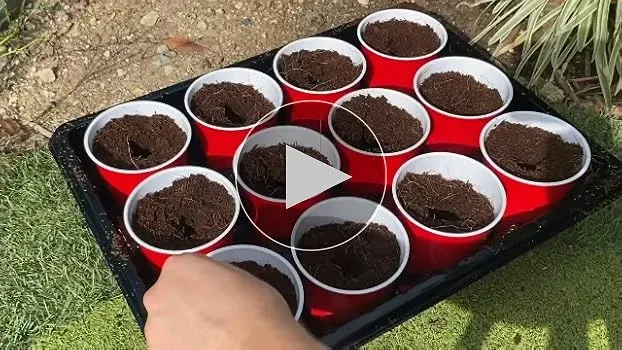Table of Contents
So, you're thinking about sprucing up your garden, huh? Maybe you're dreaming of vibrant flowers bursting with color, or maybe you're just trying to keep those pesky weeds at bay. Either way, mulch is your secret weapon. But with so many Mulch types out there, it can feel like navigating a jungle of wood chips and shredded bark. Don't worry, we're here to help! This article from lilyflower.homes will guide you through the wonderful world of mulch, exploring different mulch types, their pros and cons, and how to use them effectively. We’ll cover everything from the classic wood chips to the more unusual options, helping you choose the perfect mulch to make your garden thrive. Get ready to become a mulch master! We'll examine into the different mulch types available, explore their unique benefits, and help you decide which one best suits your needs and gardening style. Prepare to transform your garden from drab to fab!
![10 Essential Mulch Types For Your Garden [2024 Guide]](https://lilyflower.homes/api/media/file/10-essential-mulch-types-for-your-garden-2024-guide-1.webp)
10 Essential Mulch Types For Your Garden [2024 Guide]
Understanding Different Mulch Types

Understanding Different Mulch Types
What is Mulch and Why is it Important?
Mulch is any material used to cover the soil, retaining moisture, suppressing weeds, and regulating temperature. It's like a warm blanket for your garden, keeping it cozy and comfortable. Mulch can be made from a variety of materials, including wood chips, leaves, straw, and even plastic.
In this article, we'll explore the different and their benefits, helping you choose the perfect one for your garden. Whether you're looking to improve soil health, reduce maintenance, or simply add a decorative touch, the right mulch can make all the difference.
Organic vs. Inorganic Mulch
Organic mulch, such as wood chips or leaves, is made from natural materials that break down over time. It's like compost, but instead of being mixed into the soil, it's spread on top. Inorganic mulch, like plastic or rubber, doesn't break down and can last for years. However, it may not be as eco-friendly as organic options.
Here are some popular organic and inorganic mulch options:
- Wood chips
- Leaves
- Straw
- Pine straw
- Grass clippings
- Plastic sheeting
- Rubber mulch
Mulch Benefits for Your Garden
Mulch can provide numerous benefits for your garden, including:
Benefit | Description |
|---|---|
Soil Temperature Regulation | Mulch helps keep the soil at a consistent temperature, promoting healthy root growth. |
Moisture Retention | Mulch reduces soil evaporation, retaining moisture and reducing the need for frequent watering. |
Weed Suppression | Mulch prevents weeds from growing by blocking light and preventing seed germination. |
As you can see, mulch is an essential component of any garden. By choosing the right mulch type and applying it correctly, you can improve soil health, reduce maintenance, and create a beautiful, thriving garden. Check out our article on container gardening for more tips on how to create a stunning garden.
Choosing the Right Mulch for Your Garden

Choosing The Right Mulch For Your Garden
Picking the perfect mulch is like choosing the right outfit – it depends on the occasion! Think of your plants: are they delicate little seedlings needing a gentle hug, or are they tough mature plants that can handle a bit more? For example, delicate herbs might appreciate a light layer of shredded leaves, keeping them cozy and preventing their roots from getting too hot. Meanwhile, those thirsty roses might love a thicker layer of wood chips to hold onto moisture during a sunny summer. It’s all about finding the right match!
Your soil type plays a big part too. If you've got sandy soil that drains super fast, you might want a mulch that helps retain moisture, maybe something like aged compost. But if your soil tends to get waterlogged, you'll want something that lets water drain through, like pine bark nuggets. It's like finding the right shoes for a rainy day – you wouldn't wear flip-flops in a hurricane, would you? Learn more about improving your soil's drainage with our drainage tips.
Mulch Type | Best For | Pros | Cons |
|---|---|---|---|
Wood Chips | Most plants | Affordable, breaks down to improve soil | Can be messy, needs replenishing |
Straw | Vegetables, annuals | Light, easy to apply | Breaks down quickly, can harbor pests |
Pine Bark Nuggets | Acid-loving plants, drainage issues | Long-lasting, good drainage | Can be expensive |
Don't forget about aesthetics! Mulch isn't just functional; it can add a beautiful touch to your garden. Think about the color of your mulch and how it complements your plants and overall garden design. A dark mulch can make vibrant flowers pop, while a lighter mulch can create a more airy, natural look. You can even mix and match different types for a unique look. For example, I once used a mix of cocoa bean mulch and wood chips around my hydrangeas—it looked amazing!
And finally, consider the long-term effects. Some mulches break down quickly, adding nutrients to your soil as they decompose. Others last for years, providing consistent weed suppression and moisture retention. Think about your time commitment and how much effort you want to put into maintaining your garden. You might even want to explore different compost types to add to your mulch for extra benefits.
- Consider your plant's needs.
- Think about your soil type.
- Choose a mulch that complements your garden's style.
- Think about long-term effects and maintenance.
Remember, choosing the right mulch is a bit of a science, but mostly a fun experiment! It’s all about learning what works best for your garden and your plants. Don’t be afraid to try different things and see what you like best. It's part of the joy of gardening, right? Plus, you can always adjust your mulch strategy as you learn more about your garden's needs.
I once made the mistake of using the wrong mulch for my tomatoes—they ended up with root rot! Now I'm a mulch expert, and I'm happy to share my knowledge with you. Check out our other posts on soil requirements and fertilizers to get even more tips!
Applying Mulch: Techniques and Tips
How to Apply Mulch Properly
Applying mulch is like putting on a cozy blanket for your garden. It’s not just about dumping a bunch of material on top of the soil; it’s about doing it right. Start by clearing the area of any weeds or debris. This is like making your bed before you tuck in. You want a clean, smooth surface to work with. Once your garden bed is prepped, spread the mulch evenly with a rake or your hands. A layer of about 2-3 inches is usually perfect. It’s like spreading frosting on a cake—too thin, and it won’t cover properly; too thick, and it might suffocate your plants.
When mulching around trees or shrubs, keep the mulch a few inches away from the trunk. Think of it as giving your plants some breathing room. Piling mulch right up against the trunk can cause water to collect and lead to rot. It’s like when you wear a tight jacket in the rain—your skin gets damp and uncomfortable. Also, avoid creating mulch volcanoes, which are those tall mounds of mulch that look like mountains around the base of a tree. This can also cause root issues and attract pests. For more tips on maintaining healthy roots, check out our root health guide.
Tip | Description |
|---|---|
Clear the area | Remove weeds and debris for a clean surface. |
Even layer | Spread mulch evenly, about 2-3 inches thick. |
Keep space from trunks | Leave a few inches of space around tree and shrub trunks. |
Avoid mulch volcanoes | Don’t pile mulch high around tree bases. |
When to Apply Mulch
The timing of your mulch application can make a big difference. Spring is a great time to mulch because the soil is warming up, and plants are starting to grow. It helps retain moisture and regulate soil temperature, which is crucial as the weather gets warmer. Fall is another excellent time to mulch. As temperatures start to drop, mulch acts as a protective layer, insulating the soil and roots from the cold. It’s like putting on a warm coat before stepping out into the chilly autumn air. Plus, organic mulches can help improve soil health over the winter months.
When applying mulch, make sure the soil is moist. This helps the mulch settle and provides the best conditions for your plants. Also, consider the weather. A light rain can help settle the mulch, but a heavy downpour might wash it away. It’s like packing for a trip—make sure you’re prepared for different conditions. If you’re planting in containers, mulching can be just as important. It helps retain moisture and control temperature, which can be crucial for container gardens. Learn more about container gardening in our .
- Spring: Helps retain moisture and regulate temperature.
- Fall: Insulates soil and roots from cold.
- Moist soil: Apply mulch when the soil is moist.
- Weather conditions: Consider the weather before applying mulch.
Mulch Types and Their Benefits: A Comprehensive Guide
When it comes to choosing the right mulch for your garden, the options can be overwhelming. But don't worry, I've got you covered. As a seasoned gardener, I've tried my fair share of and learned what works best for different plants and soil types. In this article, I'll share my knowledge with you, so you can make an informed decision and give your garden the TLC it deserves.
Mulch is like a warm hug for your garden. It retains moisture, suppresses weeds, and regulates soil temperature. But with so many types available, it's essential to choose the right one for your specific needs. From wood chips to straw, and from organic to inorganic, the choices can be daunting. But don't worry, I'll break it down for you. Let's start with the basics.
Mulch Type | Brief Description | Benefits |
|---|---|---|
Wood Chips | A popular organic mulch made from wood waste. | Attractive, affordable, and breaks down to improve soil. |
Straw | A lightweight, organic mulch made from dried plant material. | Easy to apply, inexpensive, and adds nutrients to soil. |
Now that you've got a basic understanding of the different mulch types, it's time to explore their benefits in more detail. From improving soil health to reducing maintenance, the advantages of using mulch in your garden are numerous.
One of the most significant benefits of mulch is its ability to retain moisture in soil moisture. This is especially important during hot summer months when plants can quickly dry out. By applying a layer of mulch, you can reduce the need for frequent watering and keep your plants healthy and thriving. Check out my article on watering lilies for more tips on keeping your plants hydrated.
- Improves soil health
- Reduces maintenance
- Attractive and decorative
- Reduces soil erosion
As you can see, the benefits of using mulch in your garden are numerous. By choosing the right type and applying it correctly, you can create a beautiful, thriving garden that requires minimal maintenance. Remember to always follow proper application techniques and enjoy the many advantages of using mulch in your garden.
Final Thought
Choosing the right mulch can significantly impact your garden's health and beauty. Remember to consider your specific needs, the type of plants you're growing, and your personal aesthetic preferences. With a little research and planning, you can create a thriving garden that’s both visually stunning and environmentally friendly. Happy gardening!